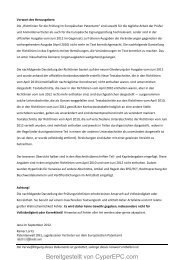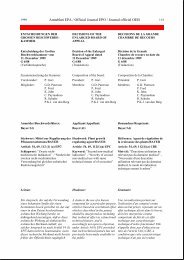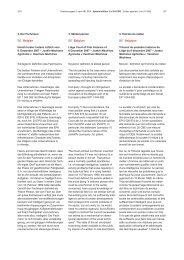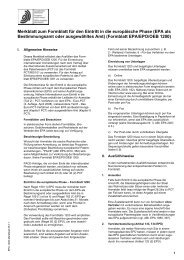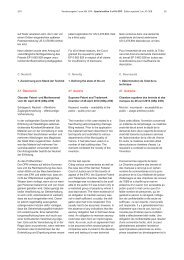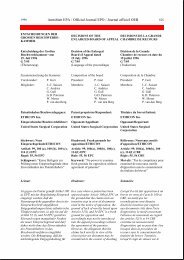Sonderausgabe 1 zum AB - CyberEPC
Sonderausgabe 1 zum AB - CyberEPC
Sonderausgabe 1 zum AB - CyberEPC
You also want an ePaper? Increase the reach of your titles
YUMPU automatically turns print PDFs into web optimized ePapers that Google loves.
144 <strong>Sonderausgabe</strong> 1 <strong>zum</strong> <strong>AB</strong>l. EPA Special edition 1 of OJ EPO Edition spéciale 1 du JO OEB 2011<br />
48. Warum ist es also nicht legitim,<br />
"Stoff X in Verbindung mit Anweisungen<br />
für seine Verwendung im Verfahren Y"<br />
zu beanspruchen? Ein EPA-Fall und ein<br />
englischer Fall legen nahe, dass dies<br />
nicht möglich sei. Ich frage mich aber,<br />
warum dem so sein sollte 16 .<br />
49. Im oben erwähnten Fall wird der<br />
Grundsatz, dass der Zweck generell<br />
Neuheit verleihen kann, in einem obiter<br />
dictum offenbar in gewisser Weise<br />
gebilligt:<br />
"Anders verhält es sich nach der Rechtsprechung<br />
des EPA, die 1984 im Fall<br />
Eisai begründet wurde. Bevor wir näher<br />
auf Eisai eingehen, ist es wichtig, auf<br />
eine parallele, eng damit zusammenhängende<br />
Entwicklung hinzuweisen, die<br />
etwas später in einem anderen Zusammenhang<br />
als dem der medizinischen<br />
Verwendung eingetreten ist. In [Mobil]<br />
hat die Große Beschwerdekammer festgestellt,<br />
dass die "Verwendung von X als<br />
reibungsverringender Zusatz in einem<br />
Schmiermittel" neu sei, obwohl die Verwendung<br />
von X in einem solchen Mittel<br />
zur Verhinderung von Rostbildung<br />
bekannt war. Ein neuer Zweck für eine<br />
Verwendung kann auch dann Neuheit<br />
begründen, wenn der Stoff alt und als<br />
solcher nicht patentierbar ist. Lord<br />
Hoffmann hat in Merrell Dow v Norton<br />
[1996] RPC 76 auf die Schwierigkeiten<br />
hingewiesen, die sich bei dieser Art<br />
Anspruch im Hinblick auf eine Patentverletzung<br />
ergeben könnten, hat aber<br />
offensichtlich bewusst davon abgesehen,<br />
einen Verwendungsanspruch des<br />
Typs "Mobil " für ungültig zu erklären."<br />
(Hervorhebung hinzugefügt).<br />
50. Später führt der Richter aus:<br />
"Die rechtspolitischen Gründe, derartige<br />
Ansprüche zuzulassen, ähneln stark<br />
denjenigen, die hinter Mobil/reibungsverringernder<br />
Zusatz stehen (ohne die<br />
Komplikation durch das Verbot von<br />
48. So why is it not legitimate to claim<br />
"Compound X coupled with instructions<br />
for use in method Y"? An EPO and an<br />
English case suggested this was not<br />
possible. But I question why that should<br />
be so 16 .<br />
49. The same case appears to give<br />
some obiter approval for the principle<br />
that purpose may confer novelty<br />
generally:<br />
"Things are different under EPO case<br />
law as was first established in Eisai in<br />
1984. Before we examine Eisai in more<br />
detail it is important to note a parallel,<br />
closely related, development which<br />
occurred a little later but outside the<br />
context of medical use. In [Mobil] the<br />
"use of X as a friction reducing additive<br />
in a lubricant composition" was held by<br />
an Enlarged Board new notwithstanding<br />
the fact that the use of X in such a<br />
composition for the purpose of rust inhibition<br />
was known. Novelty of purpose<br />
for use can confer novelty even if the<br />
substance is old and unpatentable as<br />
such. Lord Hoffmann in Merrell Dow v<br />
Norton [1996] RPC 76 noted the difficulties<br />
which this sort of claim may cause<br />
in respect of infringement but clearly<br />
deliberately refrained from holding that<br />
a Mobil-type use claim is invalid."<br />
(emphasis added).<br />
50. Later he said:<br />
"The policy reason for allowing such<br />
claims is closely akin (without the<br />
complication of the ban on therapeutic<br />
use claims) to that behind Mobil/friction<br />
reducing additives. As Jacob J observed<br />
48. Pourquoi donc ne peut-on pas<br />
formuler une revendication sous la forme<br />
"Composé X avec instructions d'utilisation<br />
pour usage dans la méthode Y" ?<br />
D'après une décision de l'OEB et une<br />
autre décision anglaise, cela ne serait<br />
pas possible. Or, je me demande pourquoi<br />
il devrait en être ainsi 16 .<br />
49. La même affaire semble approuver<br />
par obiter dictum le principe selon lequel<br />
la finalité d'une invention peut lui conférer<br />
la nouveauté en règle générale :<br />
"Les choses sont différentes selon la<br />
jurisprudence de l'OEB telle que fixée<br />
pour la première fois dans l'affaire Eisai<br />
en 1984. Avant d'examiner Eisai plus<br />
en détail, il importe de noter un développement<br />
parallèle et très proche intervenu<br />
un peu plus tard mais en dehors<br />
du contexte médical. Dans [Mobil], la<br />
Grande Chambre de recours a jugé<br />
que "l'utilisation du produit X comme<br />
additif de diminution des frottements<br />
dans la composition d'un lubrifiant"<br />
constituait une nouveauté, nonobstant<br />
le fait que l'on connaissait l'utilisation<br />
de X dans une telle composition en tant<br />
qu'agent antirouille. La nouveauté de la<br />
finalité d'utilisation peut conférer la<br />
nouveauté à un produit, même si la<br />
substance est ancienne et ne peut<br />
pas être brevetée en tant que telle.<br />
Lord Hoffmann dans l'espèce Merrell<br />
Dow v Norton [1996] RPC 76 a fait<br />
remarquer les difficultés que peut entraîner<br />
cette sorte de revendication du point<br />
de vue de la contrefaçon, mais s'est<br />
manifestement abstenu de juger qu'une<br />
revendication portant sur une utilisation<br />
de type Mobil n'est pas valable" (c'est<br />
nous qui soulignons).<br />
50. Le juge a poursuivi en ces termes :<br />
"La raison de principe pour laquelle ce<br />
type de revendications est accepté est<br />
très semblable à la raison qui sous-tend<br />
l'affaire Mobil/additifs de diminution des<br />
frottements (sans la complication de<br />
16 Ich bin Justine Pila von der Universität Oxford<br />
für den Hinweis dankbar, dass Justice Graham<br />
in einer Reihe von Entscheidungen die Patentierung<br />
von Arzneimitteln durch Bezugnahme<br />
auf ihre Verpackung als Möglichkeit zur Umgehung<br />
des Patentierungsverbots für Behandlungsverfahren<br />
gebilligt hat: Organon Laboratories<br />
[1970] RPC 574 (auf eine Karte mit<br />
Gebrauchshinweisen gepackte Antibabypillen);<br />
Blendax-Werke [1980] RPC 491 (für die sukzessive<br />
Verabreichung von Bestandteilen einer<br />
Zahnpasta ausgestaltete Packung).<br />
16 I am grateful to Justine Pila of the University of<br />
Oxford for pointing out that in a number of<br />
cases Graham J approved ways of patenting<br />
drugs by reference to their packaging as a way<br />
of circumventing the method of treatment<br />
exception: Organon Laboratories [1970] RPC<br />
574 (contraceptive pills packed on a card with<br />
instructions for use); Blendax-Werke [1980]<br />
RPC 491 (a pack arranged for the sequential<br />
administration of elements of a toothpaste).<br />
16 Je voudrais remercier ici Justine Pila de l'Université<br />
d'Oxford pour m'avoir signalé que dans<br />
un certain nombre de cas, le juge Graham a<br />
approuvé des modes de délivrance de brevet<br />
pour des médicaments en se référant à leur<br />
emballage, en tant que moyen de contourner<br />
l'exception de la méthode de traitement :<br />
Organon Laboratories [1970] RPC 574<br />
(pilules contraceptives conditionnées sur une<br />
plaquette comportant des instructions d'utilisation)<br />
; Blendax-Werke [1980] RPC 491 (pack<br />
conçu pour l'agencement séquentiel de<br />
composants d'un dentifrice).



